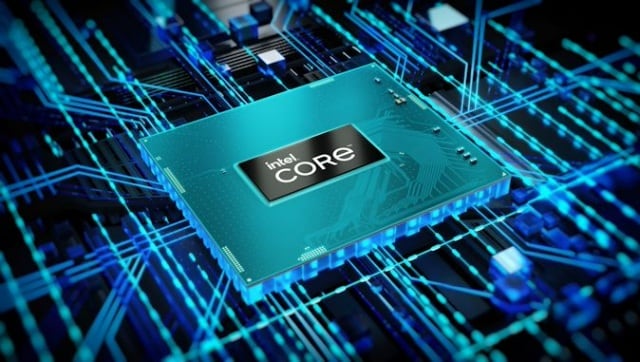Mehul Reuben DasAug 23, 2022 16:10:46 IST
Intel’s 12th Gen Processors have proven to be a massive game changer for them, especially when it comes to mobile devices, such as laptops and notebooks. Their H & HX series, in particular, which have been designed for enthusiast and desktop-replacement class laptops offers a wide range of options for all sorts of use-cases.
Whether you’re looking for some strong performance and battery longevity, or straightout hardcore desktop-like performance in a mobile form factor, the H & HX series has something or the other to offer.
What has taken most tech enthusiasts by surprise, however, is Intel’s decision to have the Alder Lake-HX series, alongside the Alder Lake-H series. The Alder Lake-HX series brings all the advantages and performance chops of Alder Lake S series, that is the desktop chips, to the HX series.
By doing so, Intel has been able to offer some additional features over their laptop-grade processors, that were previously limited to the desktop, such as support for PCIe 5.0, ECC memory, as well as a more desktop-like base TDP of 55 Watts.
We spoke to Akshay Kamath, Director, Client Sales, Intel India and discussed, how Intel is bringing performance and some niche features that were reserved for its desktop customers to its laptops customers, and what made them realise the need to do so. Edited excerpts:
What is the main difference between the H and the HX line of 12th Gen Intel CPUs?
The new 12th Gen Intel® Core™ HX processors utilize desktop-calibre silicon in a mobile package – to deliver high levels of performance for mobile gaming and professional workflows. Laptops with 12th Gen Intel Core HX processors offer several advantages over other processor series in the 12th Gen family. The HX processors offer up to 16 cores (8 P-cores + 8 E-cores) plus great advantages in memory and I/O with support for PCIe Gen 5, support for ECC memory and up to 128 GB of DDR5 RAM. The HX series of processors also will support overclocking on all SKUs. These combined deliver amazing gaming experiences as well as incredible improvements with multi-threaded workloads.
The H series goes up to 6 P-cores and 8 E-cores. Why did Intel not make an 8 P-core and 8 E-Core versions on the H series? Why did Intel have to move to the desktop die for the HX series?
12th Gen H-series had a big change this generation from a 2 chip to 1 chip package which provided TTM and performance leadership. As such, it was built on the lead 14 core die on the Alder Lake family and offered 6 P-cores and 8 E-cores. The additional space on the H die is used to increase the performance of integrated graphics for systems without discrete. 12th Gen mobile HX processors use a similar die akin to our desktop processors, but have been performance tuned, optimized, and packaged in the SBGA format for use in laptops. This packaging is similar to 11th Gen H-series processors as they used the same SBGA package. It is a chip used in a socket and could be used in other form factor systems. It is always paired with discrete graphics for the best performance for gamers and professional users.
Historically, we have seen that mobile processors, especially in the i5 range weren’t overclocking-ready, whereas with the HX processors, Intel decided to let the processors be overclocked. What was the rationale behind this?
Many laptop users want the same features they see on today’s high-end desktops. While laptops rely on OEM cooling solutions, these solutions continue to improve and are able to support overclocking on a mobile platform. This gives enthusiasts the ability to tune their laptop much as they do their desktop. 12th Gen Intel Core HX processors offer both core and memory overclocking options.
Would we be right in saying that the new HX series has been developed keeping power users such as gamers, streamers and content creators in mind?
12th Gen Intel® Core™ i9-12900HX is the fastest performance laptop processor. 12th Gen Intel Core HX processors deliver the highest mobile performance for workstation, content creation and gaming. 12th Gen Intel Core HX processors are purpose-built workstation designs and configurations to meet power users’ technical computing requirements, such as high performance, data integrity, ISV certifications, and manageability. The 12th Gen Intel Core HX processors deliver unrivalled mobile performance for mobile power users like studio creators, pro gamers and more.
With up to 16 compute cores and 24 threads, the flagship HX processors are breaking performance barriers. How big an issue will thermal throttling be with these new processors? What guidelines do OEMs need to follow to ensure that the new CPUs get adequate power delivery and manage heat dissipation?
We work closely with our OEM partners to ensure that the end product delivers to the best of its capabilities. However, all OEMs have the flexibility of designing their own custom cooling solutions, whether they be a standard solution, or something novel like the use of vapour chamber or exotic thermal interface materials. While we do have a certain degree of co-engineering that goes into making a laptop, the final choice for chassis design and the thermal solution implementation lies with the OEM partner. With 12th Gen Core HX, most OEMs have opted for designs for power users with high thermal capacity. Thermal throttling is not expected on these powerful gaming and mobile workstation designs.
Tell us something about PCIe Gen5 and the HX series. At this segment of workstation notebooks and laptops, what sort of workloads is Intel looking at that would use such high bandwidths?
With PCIe Gen5, we have set out to future proof systems powered by the HX series of processors. PCIe Gen5 doubles the bandwidth offered by PCIe Gen 4 and can be beneficial is various ways. For example, video editors working with large 4K or 8K RAW files would find load times significantly reduces when their projects are loaded off of a PCIe Gen5 SSD. As the connection matures, we also expect game developers to use the increased speed to decrease game launch and level load times. This connection is also intended to support next generation graphics that make use of these wider connections directly to the CPU.
Data integrity and data redundancy are usually not that important features for gamers, streamers or content creators. However, for the HX series Intel decided to support ECC memory on both DDR4 and DDR5 RAMs. Why?
Error Correcting Code RAM is a critical requirement in many workloads such as processing of large data or instruction sets. Even render engines, whether for video or 3D benefit from the presence of ECC RAM as it prevents the potential for data corruption as its being passed through the system memory. 12th Gen Intel Core HX series processors were created for both gamers and professional mobile workstation users. The line replaces Intel Xeon-based mobile workstations and ECC RAM is extremely important to this segment of users. ECC RAM is only supported on select Intel vPro compatible SKUs for the mobile workstation market and will not be found in typical gaming systems. This is an OEM decision.













